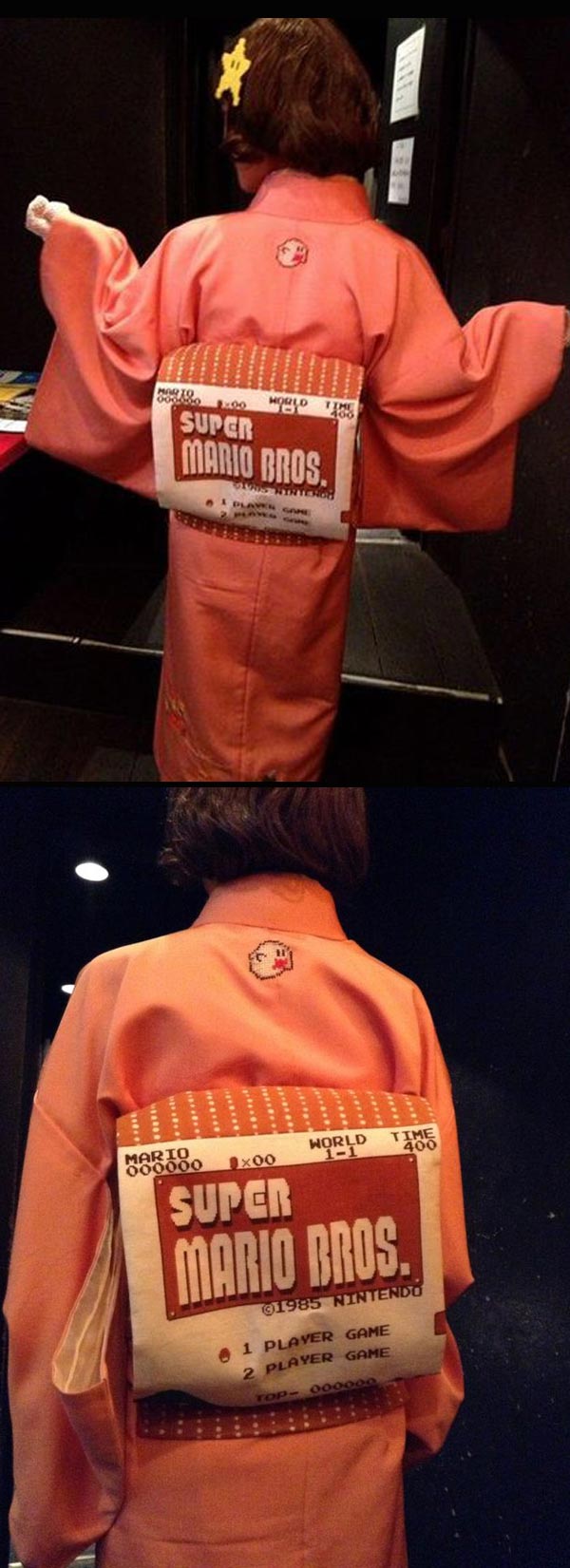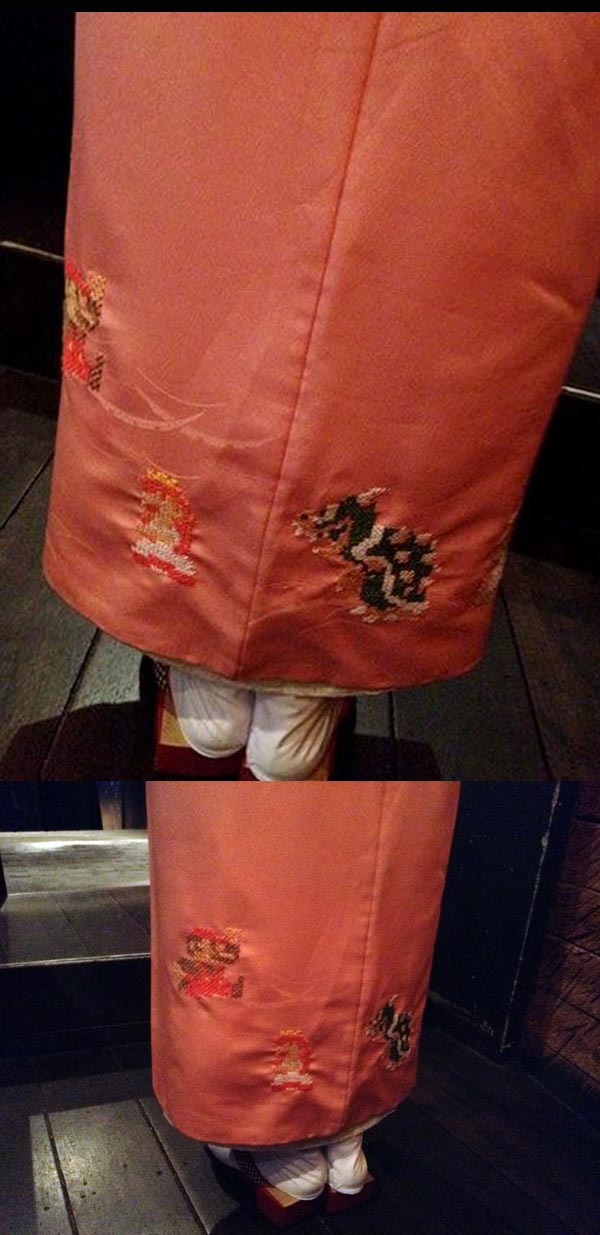Cute
Comel juga kimono bertemakan Super Mario Brothers ini! Lengkap dengan controller Nintento NES. Now all we need is kimono bertemakan Sonic.


Laporan asal CrunchyRoll


Powered by Blogger. Designed by Obefiend Design . Original Blogger Templates by Chica Blogger
first kah?
ReplyDeletehai
Deletehebat
Delete#BANkami
The kimono (着物?)[1] is a Japanese traditional garment worn by men, women and children. The word "kimono", which literally means a "thing to wear" (ki "wear" and mono "thing"),[2] has come to denote these full-length robes. The standard plural of the word kimono in English is kimonos,[3] but the unmarked Japanese plural kimono is also sometimes used.
DeleteKimono are T-shaped, straight-lined robes worn so that the hem falls to the ankle, with attached collars and long, wide sleeves. Kimono are wrapped around the body, always with the left side over the right (except when dressing the dead for burial.),[4] and secured by a sash called an obi, which is tied at the back. Kimono are generally worn with traditional footwear (especially zōri or geta) and split-toe socks (tabi).[5]
Today, kimono are most often worn by women, and on special occasions. Traditionally, unmarried women wore a style of kimono called furisode,[5] with almost floor-length sleeves, on special occasions. A few older women and even fewer men still wear the kimono on a daily basis. Men wear the kimono most often at weddings, tea ceremonies, and other very special or very formal occasions. Professional sumo wrestlers are often seen in the kimono because they are required to wear traditional Japanese dress whenever appearing in public.[6]
As the kimono has another name, gofuku (呉服?, literally "clothes of Wu (吳)"), the earliest kimonos were heavily influenced by traditional Han Chinese clothing, known today as hanfu (漢服?, kanfuku in Japanese), through Japanese embassies to China which resulted in extensive Chinese culture adoptions by Japan, as early as the 5th century AD.[5] It was during the 8th century, however, that Chinese fashions came into style among the Japanese, and the overlapping collar became particularly women's fashion.[5] During Japan's Heian period (794–1192 AD), the kimono became increasingly stylized, though one still wore a half-apron, called a mo, over it.[5] During the Muromachi age (1392–1573 AD), the Kosode, a single kimono formerly considered underwear, began to be worn without the hakama (trousers, divided skirt) over it, and thus began to be held closed by an obi "belt".[5] During the Edo period (1603–1867 AD), the sleeves began to grow in length, especially among unmarried women, and the Obi became wider, with various styles of tying coming into fashion.[5] Since then, the basic shape of both the men’s and women’s kimono has remained essentially unchanged. Kimonos made with exceptional skill from fine materials have been regarded as great works of art.[5]
The formal kimono was replaced by the more convenient Western clothes and yukata as everyday wear. After an edict by Emperor Meiji,[7] police, railroad men and teachers moved to Western clothes. The Western clothes became the army and school uniform for boys. After the 1923 Great Kantō earthquake, kimono wearers often became victims of robbery because they could not run very fast due to the restricting nature of the kimono on the body and geta clogs. The Tokyo Women's & Children's Wear Manufacturers' Association (東京婦人子供服組合) promoted Western clothes. Between 1920 and 1930 the sailor outfit replaced the undivided hakama in school uniforms for girls. The 1932 fire at Shirokiya's Nihonbashi store is said to have been the catalyst for the decline in kimonos as everyday wear. Kimono-clad Japanese women did not wear panties and several women refused to jump into safety nets because they were ashamed of being seen from below. (It is, however, suggested, that this is an urban myth.)[8][9] The national uniform, Kokumin-fuku (国民服), a type of Western clothes, was mandated for males in 1940.[10][11][12] Today most people wear Western clothes and wear the breezier and more comfortable yukata for special occasions.
cun2
ReplyDeleteSAYA berumur 18 tahun dan mempunyai masalah ketulan (bengkak seolah-olah jerawat) di bahagian faraj saya.
DeletePada mulanya, ketulan itu tidak sakit, tetapi selepas tiga hari, ketulan itu berdarah. Apabila saya picit, ia mengeluarkan darah dan berasa sakit. Setiap kali saya didatangi haid, saya memang mengalami senggugut, tetapi bulan ini saya mengalami senggugut dan sakit pinggang.
Apakah sebenarnya ketulan itu? Adakah ia fibroid? Harap doktor dapat membantu kerana saya risau memikirkan ketulan ini.
GADIS BUNTU,
Selangor
1st yes
ReplyDeleteorang tak main 1st dah zaman ni.
DeleteKetinggalan zaman dah.
Nasib baik pakai anon.
Kalau tak dah tntu kena gelak
sepanjang zaman.
hidup anon!
DeleteSangat cute! ^_^
ReplyDeleteawak lg cute, nak facebook bole?
Deletecutepepek
Deleteburuk
ReplyDeletecAp3rW nArK B1sJuT?
ReplyDelete#Anon hipster bisjut
Comey nyaa......
ReplyDeletekawaiiiiiiiiii~
ReplyDeletetapi penat lah nak comment kena word verification
bapok cheras. sap tote!
Deletenokharoommmmm tulang sutun!
Deletekomen x mesra pengguna
ReplyDeleteanon bodoh..!
ReplyDeletehail anon!!
ReplyDeleteModel dia tak cun!
ReplyDeleteThe kimono (着物?)[1] is a Japanese traditional garment worn by men, women and children. The word "kimono", which literally means a "thing to wear" (ki "wear" and mono "thing"),[2] has come to denote these full-length robes. The standard plural of the word kimono in English is kimonos,[3] but the unmarked Japanese plural kimono is also sometimes used.
ReplyDeleteKimono are T-shaped, straight-lined robes worn so that the hem falls to the ankle, with attached collars and long, wide sleeves. Kimono are wrapped around the body, always with the left side over the right (except when dressing the dead for burial.),[4] and secured by a sash called an obi, which is tied at the back. Kimono are generally worn with traditional footwear (especially zōri or geta) and split-toe socks (tabi).[5]
Today, kimono are most often worn by women, and on special occasions. Traditionally, unmarried women wore a style of kimono called furisode,[5] with almost floor-length sleeves, on special occasions. A few older women and even fewer men still wear the kimono on a daily basis. Men wear the kimono most often at weddings, tea ceremonies, and other very special or very formal occasions. Professional sumo wrestlers are often seen in the kimono because they are required to wear traditional Japanese dress whenever appearing in public.[6]
As the kimono has another name, gofuku (呉服?, literally "clothes of Wu (吳)"), the earliest kimonos were heavily influenced by traditional Han Chinese clothing, known today as hanfu (漢服?, kanfuku in Japanese), through Japanese embassies to China which resulted in extensive Chinese culture adoptions by Japan, as early as the 5th century AD.[5] It was during the 8th century, however, that Chinese fashions came into style among the Japanese, and the overlapping collar became particularly women's fashion.[5] During Japan's Heian period (794–1192 AD), the kimono became increasingly stylized, though one still wore a half-apron, called a mo, over it.[5] During the Muromachi age (1392–1573 AD), the Kosode, a single kimono formerly considered underwear, began to be worn without the hakama (trousers, divided skirt) over it, and thus began to be held closed by an obi "belt".[5] During the Edo period (1603–1867 AD), the sleeves began to grow in length, especially among unmarried women, and the Obi became wider, with various styles of tying coming into fashion.[5] Since then, the basic shape of both the men’s and women’s kimono has remained essentially unchanged. Kimonos made with exceptional skill from fine materials have been regarded as great works of art.[5]
The formal kimono was replaced by the more convenient Western clothes and yukata as everyday wear. After an edict by Emperor Meiji,[7] police, railroad men and teachers moved to Western clothes. The Western clothes became the army and school uniform for boys. After the 1923 Great Kantō earthquake, kimono wearers often became victims of robbery because they could not run very fast due to the restricting nature of the kimono on the body and geta clogs. The Tokyo Women's & Children's Wear Manufacturers' Association (東京婦人子供服組合) promoted Western clothes. Between 1920 and 1930 the sailor outfit replaced the undivided hakama in school uniforms for girls. The 1932 fire at Shirokiya's Nihonbashi store is said to have been the catalyst for the decline in kimonos as everyday wear. Kimono-clad Japanese women did not wear panties and several women refused to jump into safety nets because they were ashamed of being seen from below. (It is, however, suggested, that this is an urban myth.)[8][9] The national uniform, Kokumin-fuku (国民服), a type of Western clothes, was mandated for males in 1940.[10][11][12] Today most people wear Western clothes and wear the breezier and more comfortable yukata for special occasions.
barang bodoh kau la! jap, asal website maktab tentera kena hack endon?
ReplyDeletexde special nye pun, bese2 jer.. cume mcm actor porn jepun sikit ade model nih. huh!
ReplyDeleteprefer 1 player only...dont like threesome
ReplyDelete……………………………………..________
ReplyDelete………………………………,.-’”……………….“~.,
………………………..,.-”……………………………..”-.,
…………………….,/………………………………………..”:,
…………………,?………………………………………………\,
………………./…………………………………………………..,}
……………../………………………………………………,:`^`..}
……………/……………………………………………,:”………/
…………..?…..__…………………………………..:`………../
…………./__.(…..”~-,_…………………………,:`………./
………../(_….”~,_……..”~,_………………..,:`…….._/
……….{.._$;_……”=,_…….”-,_…….,.-~-,},.~”;/….}
………..((…..*~_…….”=-._……”;,,./`…./”…………../
…,,,___.\`~,……”~.,………………..`…..}…………../
…………(….`=-,,…….`……………………(……;_,,-”
…………/.`~,……`-………………………….\……/\
………….\`~.*-,……………………………….|,./…..\,__
,,_……….}.>-._\……………………………..|…………..`=~-,
…..`=~-,_\_……`\,……………………………\
……………….`=~-,,.\,………………………….\
…………………………..`:,,………………………`\…………..__
……………………………….`=-,……………….,%`>–==“
…………………………………._\……….._,-%…….`\
……………………………..,<`.._|_,-&“……………
hahaha
ReplyDeleteDouble thumbs up! Indeed, seriously cute, timeless, and eye-catching, especially the cross-stitched patterns on the obi. Think i can actually do this cross-stitch thing on a plain old but definitely still good Japanese kimono that i love so dearly.
ReplyDelete